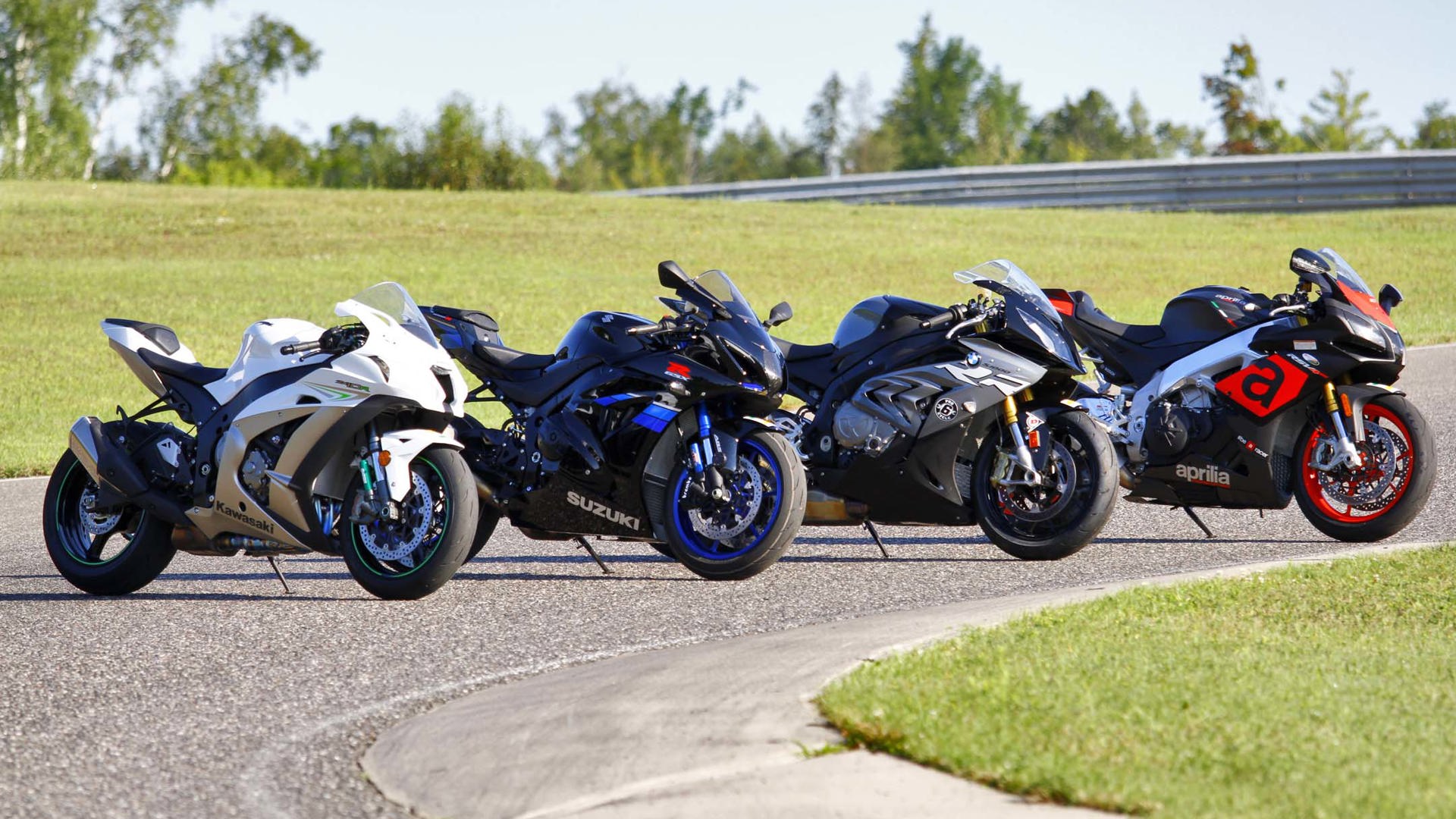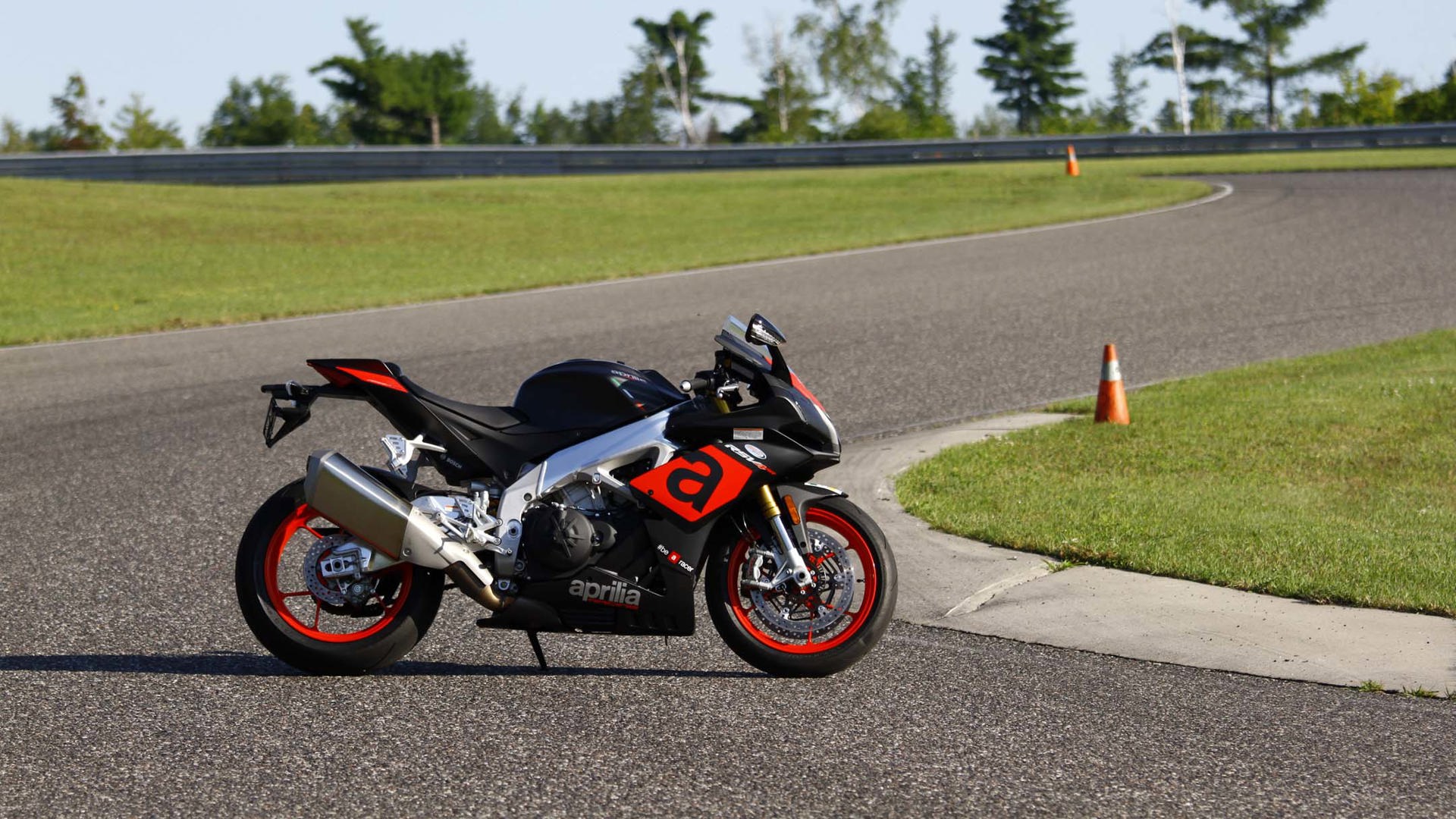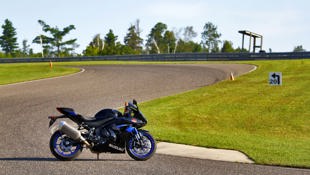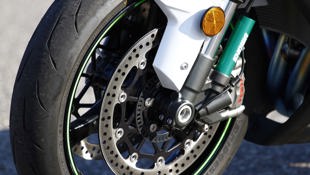Comparison Data
|
2017 Aprilia RSV4 RR
|
2017 BMW S1000RR
|
2017 Kawasaki Ninja ZX-10R
|
2017 Suzuki GSX-R1000R
|
|---|---|---|---|
|
Engine Displacement
1,000 cc
|
999 cc
|
998 cc
|
1,000 cc
|
|
Engine Cylinders
V4
|
I4
|
I4
|
I4
|
|
Peak Horsepower
201 hp
|
199 hp
|
207 hp
|
199 hp
|
|
Peak Torque
85 lb-ft
|
83 lb-ft
|
84 lb-ft
|
87 lb-ft
|
|
Fuel Economy
N/A
|
N/A
|
N/A
|
N/A
|
|
Cargo Space
N/A
|
N/A
|
N/A
|
N/A
|
|
Base Price
$17,995
|
$18,200
|
$18,199
|
$21,899
|
|
A/C Tax
N/A
|
N/A
|
N/A
|
N/A
|
|
Destination Fee
N/A
|
N/A
|
N/A
|
N/A
|
|
Price as Tested
$17,995
|
$19,200
|
$18,199
|
$21,899
|
|
Optional Equipment
None
|
$1,000 – Dynamic Package $1,000
|
None
|
None
|
Photos by Dave Beaudoin, Heather Bashow, and Didier Constant
At the top of the motorcycle food chain there is a breed of bikes that follow a similar pattern. With around 1,000 cc; low, angled handle bars; full fairing; and high, back-set foot controls; these are the big sharks in the pool.
Superbikes are proof that God wanted us to ride motorcycles.
They go by many names, and all of them are spoken in hushed tones: sport bike, litre bike, superbike. Murdercycle.
These bikes instill fear, respect, and awe.
There are some who believe that the days of the litre bike are numbered: Insurance premiums, competing interests, and even an influx of exciting, cheaper, and more accessible motorcycles all being blamed for this downturn in superbike sales.
And no, you can’t reach their full potential on the road; and yes, 90 percent of us won’t even come close on the track – but that’s not the point.
Superbikes are proof that God wanted us to ride motorcycles.
Which is why, through all the doom and gloom, the best in the business keep producing ever faster, ever better, and ever more desirable bikes at the very highest echelons of motorcycledom.
So let’s be serious: Litre bikes will exist until they legislate them out of existence, because they are brilliant. So in this hyper-competitive environment, which one deserves your attention?
For this test, we teamed up with motoplus.ca’s Didier Constant, a long-time reviewer and avid racer – including on the European endurance circuit. He brought with him fellow motoplus.ca contributors Patrick Laurin and Alain Paquin, as well as our photographer, Dave Beaudoin.
Assembled in the paddock at Calabogie Motorsports Park were four of the best and brightest from the flagship motorcycle class: the 2017 Kawasaki ZX-10R, with its violent, screeching engine and angry looking visage; the 2017 Suzuki GSX-R1000R, all new, all improved, all ready to rumble; the razor-sharp Aprilia RSV4 RR, which weaponizes Italian flair and stands alone as a V4 maverick; and, finally, the BMW S1000RR, which brings Germanic engineering efficiency to bear in full force against these challengers. Sadly, neither the new Honda CBR1000RR or Yamaha R1 were available.
There are no losers here. Sure, we rank them, because that’s the job, but each of these four approaches its mission in a different way, and each will appeal to different riders for different reasons. By the end, you’ll have an understanding of which bike is most likely to crack your face wide open in a smile, and which will rise up to complement your particular riding style the best.
But enough of the caveats and conciliations – on to the results.
Fourth Place: 2017 Suzuki GSX-R1000R
The 2017 Suzuki GSX-R1000R is the newest of the bikes in this test. It carries with it a pedigree unmatched in the group. If the GSX-R didn’t directly give birth to the litre-bike segment as we know it, it at least provided the platform from which the class launched.
This particular unit brings with it variable valve timing derived from Suzuki’s racing endeavours and a host of electronics. These include an 11-level traction control system, launch control, up-down quick-shifter, and cornering ABS courtesy of the six-axis Inertial Measurement Unit.
As the most expensive as-tested bike here, the GSX-R1000R was always at a slight disadvantage. In a perfect world, we’d have had the GSX-R1000 with less electronic wizardry and fewer weight-saving components, to better fare against the other trio.
However, even with the full-on R package the GSX-R just wasn’t as enjoyable to ride as the others. It was compliant and smooth, but it lacked the agility of its rivals. In fact, when ridden back-to-back with the Aprilia, the GSX-R felt downright reluctant to change direction. That made it a much more physical bike to ride.
Without reading the spec sheet, I’d have guessed the GSX-R was the heaviest, but it isn’t. In fact, its 203 kg wet weight is the lightest in the group. It also has the shortest wheelbase, and the least rake angle – meaning it should be the tip-in king of the crop.
And yet I couldn’t get it to turn with the efficiency of the others. There was a pronounced difference that I was unable to track down the source of.
A further let-down for Suzuki was the fact the two-direction quick-shifter refused to play ball. I was the fourth rider out on the Suzuki and I simply couldn’t get it to work as intended. In the end I gave up and granny-shifted. Returning to the pits my colleagues all reported the same issues.
There are positives though, the GSX-R has excellent mid-corner stability and edge grip, and the engine is a strong, consistent, linear performer. Courtesy of the cleverly subtle traction control, the GSX-R made me confident to light the wick on corner exit.
Those sexy Showa front forks (the same ones on the Kawasaki) did a great job at suppressing pitch under braking, and the riding position was the most forgiving of the quartet. It’s fair to claim the GSX-R would be the easiest to ride as a daily.
It’s also likely that all of the issues I experienced could be dialed out with a bit more suspension tuning (we left all the bikes stock) – but for now, in this back-to-back track test, the Suzuki was our least favourite.
Third Place: 2017 Aprilia RSV4 RR
The V4 grunts and rumbles distinctively and the Aprilia hauls itself to silly speeds with a frightening intensity. The 201 hp, 85 lb-ft V4 is within a hair of the output of the three inline-fours and yet feels utterly different. The low-down grunt and unique engine note charm many a motorcycle aficionado, but your writer finds it gruff and uncouth. I prefer the ascending wail of the inline-fours to this rumbling brute.
The difference is frankly subjective, and you can be sure that if the V4 is your thing, it will be your thing in a big way.
From its striking profile to vibrant colour scheme, right down to the 4.3-inch rich colour instrument panel, the RSV4 RR is an aesthetic feast. It’s exotic, in every sense of the word.
And that beauty is much, much more than skin deep. Sitting on it for the first time, the Aprilia feels distractingly firm, but that firmness soon translates to razor-sharp handling.
The Aprilia is visibly narrower than the three inline-fours and it feels that way aboard the bike too. For outright flickability, the RSV4 bests all comers. It is a scalpel.
Ergonomics that feel cramped and difficult at low speed make for fluent body English out on the track. I often find myself working hard to get my outside knee and elbow against the tank, and my head down low on the inside of the bike – on the Aprilia I fell into position naturally and easily.
The most obscure and exotic of our group comes with a surprisingly low price-tag. The lowest, in fact at $17,995. Some of that price-saving is evidenced in the build quality, where I noticed thinner, cheaper plastics in a lot of key areas, and felt like some of the gaps and fitments weren’t up to scratch against the others.
Performance-wise, however, the RSV4 RR is very much the match for any bike you want to line it up against.
If you are looking for the ultimate mid-corner weapon, look no further.
But its narrow focus and for a few minor quality quibbles relegate the RSV4 RR to third.
Second Place: 2017 Kawasaki ZX-10R
Of our four bikes, the ZX-10R was the only one that had me reaching for the traction control toggle during the course of our test. And before you roll your eyes at yet another motorcycle journo bragging about how they “turned off all the nannies to really feel the bike”… let be clear: I was turning it up.
Starting the session on Level 2 of the five-step traction control system proved to be a mistake. A near high-side out of Calabogie Motorsports Park’s final turn and then another out of turn five had me ratcheting up the safety net to level four (this isn’t my bike, after all) and then, as the session wore on, bringing it back down to three. Didier had a similar experience, and we all agreed the ZX-10R commanded the most respect on corner exit.
Get the tach needle past 9,000 rpm and the Kawasaki hurtles forward with the aural intensity of a banshee and the violence of a Viking army.
It was the only bike in the crop with a one-dimensional quick shift – up only, but the slipper clutch made for extremely forgiving downshifts and I really didn’t miss having both directions. If I’m honest, I have a hard time convincing myself to consistently use clutchless downshift when it’s available anyway. The Kawasaki gearbox has one other neat trick: a positive neutral finder. This device prevents the bike shifting past neutral if it’s stationary. Cool for finding neutral like a champion on the return to pit lane, and avoiding the awkward “is it in yet” dance.
The ZX-10R begs to be ridden hard, and takes energy to extract speed from. You have to work hard to get the most out of this bike – which is charming in its own way. The chassis is well-balanced, but favours stability and composure over agility. Mid-corner grip and confidence is high, but the way in and way out show up a gap to the S1000RR.
For the wonderfully violent engine, solid build quality, and gorgeous styling I vote this my second-favourite of the day.
It’s a bike that when you get it right, will leave the rider feeling immensely rewarded. But, for taking that much more effort to get right, the Kawasaki is edged out by the BMW.
First Place: 2017 BMW S1000RR
Some bikes are just better than others. The BMW S1000RR once again demonstrated its ability to make going fast completely effortless, and after a day of back-to-back riding, it was clear where we’d most happily spend our money.
Equipped standard with one of the best traction-control and stability systems on the market at $18,200, the S1000RR makes it hard to argue for the RR versions of many Japanese bikes. Because here you already get launch control, a pit-lane speed limiter, dynamic traction control, Ride Modes Pro, and ABS Pro.
Even paying the $1,000 for the Dynamic Package leaves the S1000RR under $20,000 – and for that $1,000 you get heated grips, plus Dynamic Damping Control on the suspension. It’s a compelling package in every possible measure.
Everything here just works.
Traction control is elegant in its execution, without ever feeling intrusive, and ABS is equally forgiving. The chassis is tuned to perfection, straddling the line between stability and agility while still feeling comfortable and communicative. The S1000RR is executed with clockwork precision.
The quick-shifter for up and down shifts is flawless, and smooth. The engine pulls cleanly, evenly and builds speed so subtly that it can (and did) catch one out.
Never mind though, because under braking the S1000RR is composed and balanced, eclipsed only by the Aprilia for its ability to accept bulk brake pressure without squirming and writhing underneath you.
A small caveat – this is only true if the rider isn’t being a complete nong: If you decide to grab a huge fistful of lever, you can and will hike the rear wheel skyward. Where the BMW shows its value is when you come to your senses and start to unwind your mistake. Then, the S1000RR simply pulls itself into line and continues on course. Use this information wisely.
When it comes to maximizing a bike’s potential, none is more accessible than the S1000RR. When it comes to outright, at the limit performance – few are better, and none are better across the board.
Looks-wise, there are some who will be turned off by the asymmetrical front end but that is really the only complaint I could make.
In every measure, I felt that the BMW was unmatched. Sure, the others have their strengths and charms, and absolutely – there are no wrong answers here.
If you chose to spend your money on any one of this quartet you’d be spending it well and not ever have a regret.
But if I was spending my money: I’d spend it on the German.



















































